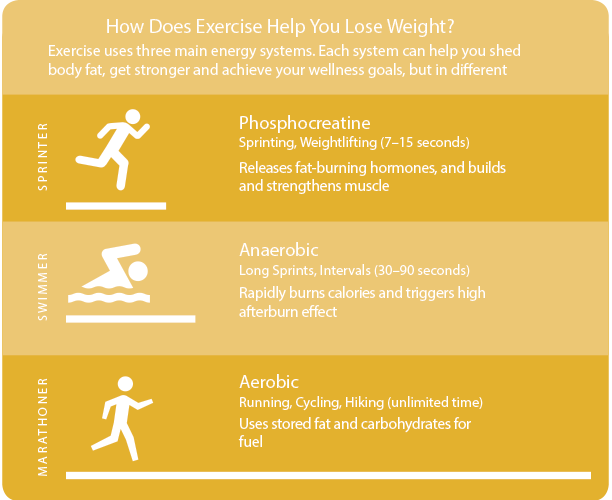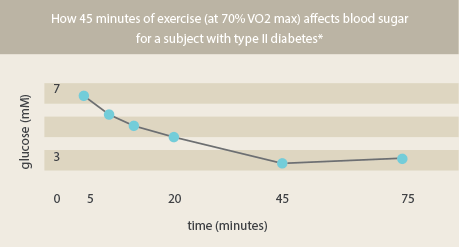What’s So Special About 45 Minutes? Exercising to lose weight

Unless you’ve been living under a rock for the last 50 years, you probably already know exercise is a crucial part of a healthy lifestyle. There’s a mountain of scientific evidence showing that exercise can help you age more gracefully, get stronger, feel more energetic, lose weight and reduce your risk for dozens of diseases and conditions. Your question probably isn’t “Should I exercise?” but rather, “What sort of exercise should I do?” and “How much of it do I need?” Vitality: Simple Steps to Your Ideal Weight™ recommends 45 minutes of exercise per day. In the paragraphs ahead, you’ll read why that is the ideal workout length and what you should do with your 45 minutes.
The Science of Exercise & Weight Loss
When your muscles contract during exercise, they release hormones that help you reduce body fat. These hormones kick off other healthy processes in your body—increasing muscle, bolstering your immune system, and even healing and protecting neurons in your brain.
 Both high-intensity and moderate-intensity exercise can help you lose weight in a variety of ways. High-intensity exercise (think sprinting, resistance training, football, wrestling, etc.) burns through large amounts of calories quickly, and builds and strengthens muscle.
Both high-intensity and moderate-intensity exercise can help you lose weight in a variety of ways. High-intensity exercise (think sprinting, resistance training, football, wrestling, etc.) burns through large amounts of calories quickly, and builds and strengthens muscle.
Moderate-intensity anaerobic or any aerobic exercise (think jogging, cycling or lap swimming) can grow the number of mitochondria (cellular power plants) in your cells, increase the volume of blood in your veins and arteries, and boost your overall cardiovascular health.
Aerobic exercise also directly taps your body’s fat-burning furnace—your aerobic metabolism—and clears sugar from your blood. An aerobic workout will start off using your body’s natural source of stored carbohydrates (called glycogen), but as you keep the workout going, you’ll increasingly use fat.
Most people’s bodies don’t surrender fat easily. A natural substance in your body called adenosine blocks your body from burning fat. But the unique blend of ingredients in the Access® Bar turns the key on adenosine, unlocking your fat stores and enabling you to use them right from the beginning of your workout.
Since the Access Bar’s introduction 20 years ago, Melaleuca customers have purchased 125 million bars and relied on them to lose weight, avoid soreness and make their workouts more enjoyable. Access Bars have also helped dozens of long-course triathletes, ultra-marathon runners, distance cyclists, and marathon swimmers to run, swim and bike thousands of miles while accessing more of their fat stores along the way. Tammy Van Wisse, for example, fueled a swim across the English Channel with Access Bars and lost 12 pounds in the process!
But most exercisers aren’t swimming the English Channel or competing in the grueling Hawaii Ironman® Triathlon. If you’re like most people, you just want to lose a little weight and get healthier, not spend an entire day swimming or cycling.
Ultimately, of course, the right exercise is the one that gives you the greatest health benefit and that you enjoy enough to keep doing
Getting The Dose Right
If it’s been a while since your schedule included regular exercise, it’s a good idea to take things one step at a time. A study of 20-to-30-year-old men who started exercising from nothing found that they lost more weight starting with 30 minutes of exercise than 60 minutes all at once. If you’re like them—starting from zero—doing 45 minutes might be too much at first. And even a daily exercise habit of 20 or 30 minutes can bring tremendous health benefits.
“A daily exercise habit is the single most powerful therapy for improving both the quality and quantity of your life,” cardiologist and researcher James O’Keefe told Runner’s World. “Getting just 30 minutes daily of moderate or vigorous physical activity can cut your risk almost in half for premature death, diabetes, Alzheimer’s disease, depression and heart attack.”
One study found that runners had a 19 percent lower risk of death than non-runners. But the data also indicated that running has a “sweet spot” with regard to health benefits: Those who ran between 10 and 20 miles per week and who ran at a pace of 8:35 to 10 minutes per mile had an even lower risk of death than those who ran less or more, or faster or slower.
That information is great if you’re a runner. But what if you prefer to ride a bicycle, swim, hike or cross-country ski? What’s your sweet spot for getting the greatest exercise benefits?
“The latest data from our studies and others strongly suggests that the ideal dose of daily vigorous exercise is about 30 to 60 minutes,” Dr. O’Keefe says. “If you do more than 60 minutes of strenuous exercise daily, you start to lose some of the health benefits seen with lesser amounts of physical activity.”
Exercising for 45 minutes can also increase the number of calories you burn throughout the day—through the “afterburn effect” or “excess post-exercise oxygen consumption.” One study showed that men who intensely rode stationary bicycles for 45 minutes would burn 190 more calories within the next 14 hours. Another study found that exercising for 45 minutes could significantly reduce your appetite.
One additional benefit of a daily 45-minute bout of exercise, particularly for diabetics, is that it clears sugar from your blood and lessens the amount of insulin circulating in your veins and arteries—which ultimately means you’ll store less sugar as fat.
So once you’ve built up to 45 minutes of exercise per day, the next step, instead of increasing the amount further, is to bump up the intensity.

So once you’ve built up to 45 minutes of exercise per day, the next step, instead of increasing the amount further, is to bump up the intensity.
Interval Training
Interval training combines aerobic and anaerobic training to give you a shortcut to some of the fitness you’d normally achieve through long aerobic exercise. For intervals to be most effective, they should be done at high intensity, hence the term “high intensity interval training” or “HIIT.”
As little as six 15-minute sessions of HIIT in two weeks can improve your muscles’ capacity for using oxygen and fat, boost your afterburn and increase your endurance. Your body will become more efficient at storing energy for workouts, and that will make it easier for you to do more exercise later.
Often, you’ll start out with a shorter “work” interval (say 10 seconds) balanced against a longer “rest” interval (perhaps two minutes). As your fitness improves, you can reduce the “rest” interval and increase the “work” interval.
“If intervals and strength training are so effective,” you’ll be tempted to ask, “should I do them all of the time?” The answer is that if your exercise regimen includes both intervals and resistance training, which can be very taxing on your body, you can wind up exhausted pretty quickly. Mixing in aerobic exercise, or “cardio,” with high-intensity interval training can help you avoid overtraining and the symptoms that come with it (irritability, interrupted sleep, injuries, delayed recovery, etc.).
Somewhere, you’ve probably heard the argument over whether intervals or cardio are superior. But the truth is that intervals and traditional aerobic exercise are not mutually exclusive; there’s no reason you can’t do both. If you don’t feel like doing a lung-searing, muscle-burning interval session, you can go for a jog, take a spin on a bicycle, enjoy a leisurely swim or do some other activity. To achieve the same results as the interval session, you’ll need to do more jogging, biking or swimming (closer to the top end of those 45 minutes), but a steady, nonstop workout is still an option.

WOW! What a terrific post. I don’t feel so guilty now doing my 45 min walk instead of getting up to an hour. Thanks. I’m off for a walk right now!
Interesting article but I have to interject some other facts in regards to strength versus aerobic exercise. Aerobic exercises are OK on a daily basis but better if you skip a day. Strength training to specific muscle groups should be at least 3 nonconsecutive days per week. Your muscles need at least 48 hours to recover from a work out. Additionally, you can gain benefits from 3 10 sessions per day in place of on longer session. I often recommend to my patients that they incorporate exercise into their daily routine as it is often difficult to devote time to one long session (i.e take the stairs, park further away from the store, get off the bus one stop sooner so you have to walk).
I have been riding my Mountan Bike on a paved trail 3 days per week. I have learned that I need the time in between for my muscles to recover. My thing has been to ride for an hour. What began as an hour now the same distance only takes 30 minutes, so I increased my route. Now that is only taking 50 minutes so I want to increase my distance again. But I have been using an hour instead of 45 minutes. My intensity has been increasing with which I am very happy. So am I doing harm by riding for an hour instead of 45 minutes? My goal has been to build lean muscle, so I can gain weight. I stand about 5’9″ and was only weighing 130#. I am now up to 135-140# and I feel so much better.
The expert quoted in the article said “30-60 minutes,” so don’t worry about doing an hour. If your goal is to gain weight, make sure to include regular Proflex20 shakes in your daily nutrition. Ideally, you want to gain lean mass rather than fat.
Hey, but with that BMI, you’re probably a really good mountain biker. Perhaps you ought to try out a race sometime, eh?